With the popularity and proliferation of book series, fitting recommended titles into just one review was impossible. This post features both the latest books in episodic series that can be read in any order and first books in new series. We have included a picture book and some early chapter books for younger readers and books with complex plots in a variety of genres for older readers. All will leave readers eagerly waiting for the next book in the series.
Ages 4–8
Bear & Hare, Where’s Bear? Emily Gravett. 2016. Simon & Schuster.
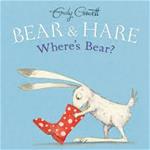 In this third Bear & Hare picture book, the two friends play hide-and-seek. As Hare counts from 1 to10, Bear hides behind a floor lamp. He chooses equally poor hiding places during two more turns. Bear isn’t good at seeking either. He looks for Hare inside a teapot, under a rug, behind a picture, and in an obviously empty bed. Observant children will notice that Bear actually is close to discovering Hare just as he gives up and snoozes in the bed. Tired of waiting to be found, Hare also gives up and goes in search of Bear. Gravett’s text is spare, and her illustrations rendered in pencil, watercolor, and wax crayon, featuring the two friends at play against expansive white backgrounds, are expressive and warmly humorous.
In this third Bear & Hare picture book, the two friends play hide-and-seek. As Hare counts from 1 to10, Bear hides behind a floor lamp. He chooses equally poor hiding places during two more turns. Bear isn’t good at seeking either. He looks for Hare inside a teapot, under a rug, behind a picture, and in an obviously empty bed. Observant children will notice that Bear actually is close to discovering Hare just as he gives up and snoozes in the bed. Tired of waiting to be found, Hare also gives up and goes in search of Bear. Gravett’s text is spare, and her illustrations rendered in pencil, watercolor, and wax crayon, featuring the two friends at play against expansive white backgrounds, are expressive and warmly humorous.
—CA
Buster the Very Shy Dog in the Great Bone Game (Buster #3). Lisze Bechtold. 2016. Houghton Mifflin Harcourt.
 In the two short chapters of this beginning reader, Buster, the brown, big-eyed, very shy puppy who comes to live at Roger’s house, must deal with Phoebe, a bone-collecting dog. “Rich is when you have lots of bones,” according to Phoebe. Phoebe tricks Buster out of his bones by offering lessons in training the bones to stay. Next, Phoebe involves Buster in her plan to steal the enormous bone of an enormous dog, Gregory, who lives next door, using her train-a-bone-to-stay trick. The plan goes awry as Phoebe is caught with the bone in her mouth. Buster, however, now feels as rich as Phoebe because he has a new friend. Bechtold’s ink-and-watercolor cartoon-like illustrations clearly express the different personalities of the three dogs and the humor of their interactions.
In the two short chapters of this beginning reader, Buster, the brown, big-eyed, very shy puppy who comes to live at Roger’s house, must deal with Phoebe, a bone-collecting dog. “Rich is when you have lots of bones,” according to Phoebe. Phoebe tricks Buster out of his bones by offering lessons in training the bones to stay. Next, Phoebe involves Buster in her plan to steal the enormous bone of an enormous dog, Gregory, who lives next door, using her train-a-bone-to-stay trick. The plan goes awry as Phoebe is caught with the bone in her mouth. Buster, however, now feels as rich as Phoebe because he has a new friend. Bechtold’s ink-and-watercolor cartoon-like illustrations clearly express the different personalities of the three dogs and the humor of their interactions.
—CA
March of the Mini Beasts (The DATA Set #1). Ada Hopper. Ill. Sam Ricks. 2016. Little Simon/Simon & Schuster.
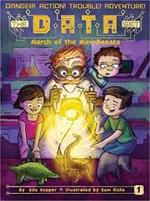 Gabriel Martinez, Laura Reyes, and Cesar Moreno are second graders at Newtonburg Elementary School. Calling themselves the DATA (Danger! Action! Trouble! Adventure!) Set, they hang out in their super futuristic treehouse and solve mysteries. After Dr. Gustav Bunsen, a mad scientist neighbor, uses his growth ray machine on their plastic toy animals, they come to life and begin to grow exponentially, and the children must find a way to take care of them. When Dr. Bunsen uses his time portal machine on Stego, Gabe’s favorite toy, the dinosaur gets whisked back to the Jurassic period, and so do they. In Book 2, Don’t Disturb the Dinosaurs (2016), the DATA Set must figure out how to return home from the Age of the Dinosaurs. With short chapters, numerous black-and-white illustrations, and fast-paced adventure, this series is a good choice for readers ready for transitional chapter books.
Gabriel Martinez, Laura Reyes, and Cesar Moreno are second graders at Newtonburg Elementary School. Calling themselves the DATA (Danger! Action! Trouble! Adventure!) Set, they hang out in their super futuristic treehouse and solve mysteries. After Dr. Gustav Bunsen, a mad scientist neighbor, uses his growth ray machine on their plastic toy animals, they come to life and begin to grow exponentially, and the children must find a way to take care of them. When Dr. Bunsen uses his time portal machine on Stego, Gabe’s favorite toy, the dinosaur gets whisked back to the Jurassic period, and so do they. In Book 2, Don’t Disturb the Dinosaurs (2016), the DATA Set must figure out how to return home from the Age of the Dinosaurs. With short chapters, numerous black-and-white illustrations, and fast-paced adventure, this series is a good choice for readers ready for transitional chapter books.
—NB
Ages 9–11
Audacity Jones to the Rescue (Audacity Jones #1). Kirby Larson. 2016. Scholastic.
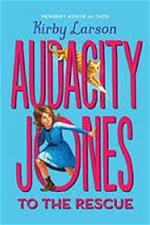 Well-read because she spends so much time in the Punishment Room (the library) of Miss Maisie’s School for Wayward Girls in Swayzee, IN, 11-year-old orphan Audacity (“Audie”) Jones is curious to see more of the world. When mysterious Commodore Crutchfield comes to the school seeking an orphan to assist him in a special mission, Audie eagerly volunteers. All she knows is that the mission involves a trip to Washington and has something to do with President Taft. As this humor-filled melodramatic adventure story unfolds, Audie is aided by Min, her clever cat, who has stowed away in the auto they are traveling in, and friends she makes in DC., including Juice, a newsboy, and Daddy Dub, his grandfather, who live in the White House stables. Together they foil the plan of the commodore and his accomplice, Eva Finch, to kidnap President Taft’s niece. The author’s note makes clear what is fiction and what is fact in this first adventure of Audacity Jones.
Well-read because she spends so much time in the Punishment Room (the library) of Miss Maisie’s School for Wayward Girls in Swayzee, IN, 11-year-old orphan Audacity (“Audie”) Jones is curious to see more of the world. When mysterious Commodore Crutchfield comes to the school seeking an orphan to assist him in a special mission, Audie eagerly volunteers. All she knows is that the mission involves a trip to Washington and has something to do with President Taft. As this humor-filled melodramatic adventure story unfolds, Audie is aided by Min, her clever cat, who has stowed away in the auto they are traveling in, and friends she makes in DC., including Juice, a newsboy, and Daddy Dub, his grandfather, who live in the White House stables. Together they foil the plan of the commodore and his accomplice, Eva Finch, to kidnap President Taft’s niece. The author’s note makes clear what is fiction and what is fact in this first adventure of Audacity Jones.
—CA
A Dragon’s Guide to Making Your Human Smarter (A Dragon’s Guide #2). Laurence Yep & Joanne Ryder. Ill. Mary GrandPré. 2016. Crown/Random House.
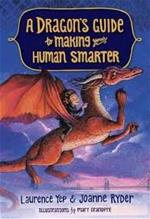 In this sequel to A Dragon’s Guide to the Care and Feeding of Humans (2015), Miss Drake, a 3,000-year-old dragon who can disguise herself as a human, arranges for Winnie, her pet human, to attend The Spriggs Academy, an extraordinary school for humans and magicals. Granddad Jarvis is plotting anew to kidnap Winnie, and Miss Drake and her cronies are intent on foiling his plan. When Nanette, Winnie’s nemesis at school, traps her into assisting in her magic act at the Halloween Festival and the trick goes terribly wrong, Granddad Jarvis finally has the evidence he needs to step in legally and have the court declare Winnie’s mother unfit. If Winnie can discover the secret word that Great-Aunt Amelia, his sister, used to control him, can a miracle happen to keep her, her mother, and Miss Drake together? Adventure, magic, humor, and charming black-and-white spot illustrations pull readers through action-packed chapters told from the alternating perspectives of Winnie and Miss Drake.
In this sequel to A Dragon’s Guide to the Care and Feeding of Humans (2015), Miss Drake, a 3,000-year-old dragon who can disguise herself as a human, arranges for Winnie, her pet human, to attend The Spriggs Academy, an extraordinary school for humans and magicals. Granddad Jarvis is plotting anew to kidnap Winnie, and Miss Drake and her cronies are intent on foiling his plan. When Nanette, Winnie’s nemesis at school, traps her into assisting in her magic act at the Halloween Festival and the trick goes terribly wrong, Granddad Jarvis finally has the evidence he needs to step in legally and have the court declare Winnie’s mother unfit. If Winnie can discover the secret word that Great-Aunt Amelia, his sister, used to control him, can a miracle happen to keep her, her mother, and Miss Drake together? Adventure, magic, humor, and charming black-and-white spot illustrations pull readers through action-packed chapters told from the alternating perspectives of Winnie and Miss Drake.
—NB
Ages 12–14
The Great White Shark Scientist (Scientists in the Field). Sy Montgomery. Photographs by Keith Ellenbogen. 2016. Houghton Mifflin Harcourt.
 In her latest Scientists in the Field book, Sy Montgomery introduces readers to the great white shark. She follows the work of shark biologist Dr. Greg Skomal and his research team during a summer as they video record and tag great white sharks in the waters off Cape Cod and then gets a close-up look at great white sharks in a dive in a submersible cage with Mexican biologist Erick Higuera off Guadalupe Island. By including numerous quotations, Montgomery shows the researchers’ enthusiasm in spite of the often routine and disappointing nature of their work (limiting weather conditions, infrequent shark sightings). The book contains an abundance of color photographs taken by Keith Ellenbogen from both the research vessels and a small spotter plane. One- to four-page inserts at the end of chapters provide additional information on research and conservation efforts related to the great white shark. Back matter includes shark maps, a bibliography, web resources, acknowledgments, and an index.
In her latest Scientists in the Field book, Sy Montgomery introduces readers to the great white shark. She follows the work of shark biologist Dr. Greg Skomal and his research team during a summer as they video record and tag great white sharks in the waters off Cape Cod and then gets a close-up look at great white sharks in a dive in a submersible cage with Mexican biologist Erick Higuera off Guadalupe Island. By including numerous quotations, Montgomery shows the researchers’ enthusiasm in spite of the often routine and disappointing nature of their work (limiting weather conditions, infrequent shark sightings). The book contains an abundance of color photographs taken by Keith Ellenbogen from both the research vessels and a small spotter plane. One- to four-page inserts at the end of chapters provide additional information on research and conservation efforts related to the great white shark. Back matter includes shark maps, a bibliography, web resources, acknowledgments, and an index.
—CA
Poison Is Not Polite (Wells & Wong Mystery #2). Robin Stevens. 2016. Simon & Schuster.
 In 1930s England, the Detective Society duo of Daisy Wells and Hazel Wong (joined by boarding school chums Kitty and Beanie) unexpectedly take on a new case during a holiday at Fallingford, the country estate of Lord and Lady Hastings, Daisy’s parents, when a houseguest, Denis Curtis, falls ill at Daisy’s 14th birthday party and dies. The Detective Society believes the unlikeable Mr. Curtis, who had a keen interest in the valuable antiques and paintings in the mansion as well as in Lady Hastings, was poisoned with arsenic-laced tea. Severe flooding has isolated Fallingford—no one can leave and the police cannot enter. It is up to the Detective Society to examine the motives and opportunities of all suspects and identify the murderer before the police arrive, particularly because Lord Hastings looks like the prime suspect. Readers who missed the first book, Murder Is Bad Manners (2015), will want to read it while they wait for the next book in the series.
In 1930s England, the Detective Society duo of Daisy Wells and Hazel Wong (joined by boarding school chums Kitty and Beanie) unexpectedly take on a new case during a holiday at Fallingford, the country estate of Lord and Lady Hastings, Daisy’s parents, when a houseguest, Denis Curtis, falls ill at Daisy’s 14th birthday party and dies. The Detective Society believes the unlikeable Mr. Curtis, who had a keen interest in the valuable antiques and paintings in the mansion as well as in Lady Hastings, was poisoned with arsenic-laced tea. Severe flooding has isolated Fallingford—no one can leave and the police cannot enter. It is up to the Detective Society to examine the motives and opportunities of all suspects and identify the murderer before the police arrive, particularly because Lord Hastings looks like the prime suspect. Readers who missed the first book, Murder Is Bad Manners (2015), will want to read it while they wait for the next book in the series.
—CA
Ages 15+
Lady Midnight (The Dark Artifices #1). Cassandra Clare. 2016. Margaret K. McElderry/Simon & Schuster.
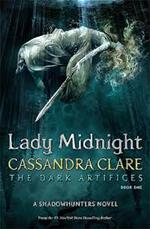 It is five years after the Dark War (in the final book of The Mortal Instruments series), and there are new Cold Peace laws to prevent Shadowhunters from mixing into faerie business. Emma Carstairs and Julian Blackthorn are parabatai, shadowhunters sworn to be platonically loyal to each other forever. Living in the Institute in Southern California, Emma and Julian illegally investigate recent murders of mundanes and faeries for clues to the unsolved murders of Emma’s parents years before. In an illegal bargain between Julian and the King of the Hunt, who kidnapped Mark, his half-fey brother, five years earlier, Mark is returned to them for two weeks to help solve the murders. Emma, Julian, his family, and Cristina, a visiting Shadowhunter from Mexico, face a deadline as they search for the complex truth against a ticking clock with them as the next victims. Throughout the novel, refrains from Edgar Allen Poe’s poem “Annabel Lee” resound like a haunting melody, providing clues about the murders, but nothing prepares Emma and Julian—and the reader—for the truth as it explodes into the final chapter. The Dark Artifices trilogy promises to keep excitement running at a high pitch for Cassandra Clare fans.
It is five years after the Dark War (in the final book of The Mortal Instruments series), and there are new Cold Peace laws to prevent Shadowhunters from mixing into faerie business. Emma Carstairs and Julian Blackthorn are parabatai, shadowhunters sworn to be platonically loyal to each other forever. Living in the Institute in Southern California, Emma and Julian illegally investigate recent murders of mundanes and faeries for clues to the unsolved murders of Emma’s parents years before. In an illegal bargain between Julian and the King of the Hunt, who kidnapped Mark, his half-fey brother, five years earlier, Mark is returned to them for two weeks to help solve the murders. Emma, Julian, his family, and Cristina, a visiting Shadowhunter from Mexico, face a deadline as they search for the complex truth against a ticking clock with them as the next victims. Throughout the novel, refrains from Edgar Allen Poe’s poem “Annabel Lee” resound like a haunting melody, providing clues about the murders, but nothing prepares Emma and Julian—and the reader—for the truth as it explodes into the final chapter. The Dark Artifices trilogy promises to keep excitement running at a high pitch for Cassandra Clare fans.
—NB
Shades of Darkness (Ravenborn #1). A.R. Kahler. 2016. Simon Pulse/Simon & Schuster.
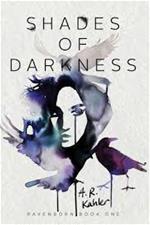 Kaira Winters transfers to Islington Arts Academy, in the woods of Michigan, as a junior visual arts student to escape from what happened to her at her former school. She strives to put the past behind her by throwing herself into her coursework and preparing for her senior project show, a paint and collage display of her life in tarot cards. However, Kaira can’t escape the crows that have followed her to the boarding school; she sees them everywhere, on her windowsill, on buildings, and in her nightmares. Remembering what happened previously, her number one rule is to never fall in love again but, when Chris, an enamored classmate, wants to get to know her better, her resolve falters. After two girls commit suicide, Kaira feels responsible for not protecting them. Is there something cosmic at work here, a power that demands payment to even the score? When her academic advisor and literature teacher insists that she attend his independent group study on arcane aspects of mythology, the unimaginable happens and changes everything. The book ends with a totally unexpected twist, leaving loose ends that whet the reader’s appetite for Book 2.
Kaira Winters transfers to Islington Arts Academy, in the woods of Michigan, as a junior visual arts student to escape from what happened to her at her former school. She strives to put the past behind her by throwing herself into her coursework and preparing for her senior project show, a paint and collage display of her life in tarot cards. However, Kaira can’t escape the crows that have followed her to the boarding school; she sees them everywhere, on her windowsill, on buildings, and in her nightmares. Remembering what happened previously, her number one rule is to never fall in love again but, when Chris, an enamored classmate, wants to get to know her better, her resolve falters. After two girls commit suicide, Kaira feels responsible for not protecting them. Is there something cosmic at work here, a power that demands payment to even the score? When her academic advisor and literature teacher insists that she attend his independent group study on arcane aspects of mythology, the unimaginable happens and changes everything. The book ends with a totally unexpected twist, leaving loose ends that whet the reader’s appetite for Book 2.
—NB
Nancy Brashear is Professor Emeritus of English from Azusa Pacific University, in Azusa, CA. Carolyn Angus is former director of the George G. Stone Center for Children's Books, Claremont Graduate University, in Claremont, CA.
These reviews are submitted by members of the International Literacy Association's Children's Literature and Reading Special Interest Group (CL/R SIG) and are published weekly on Literacy Daily.